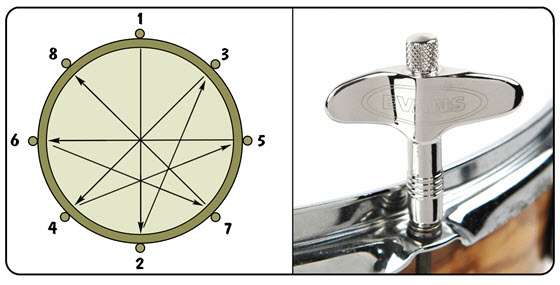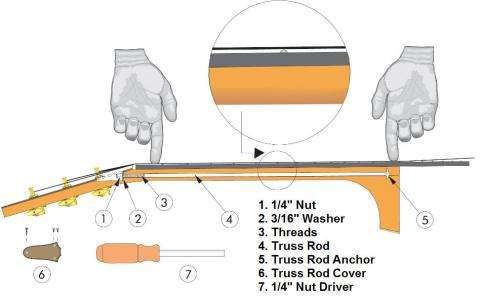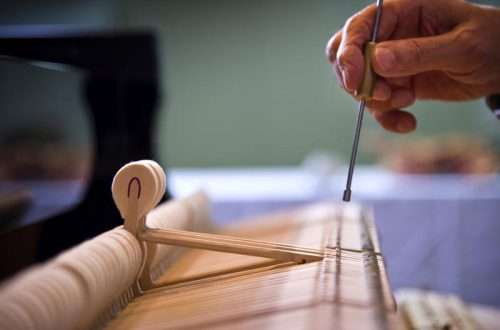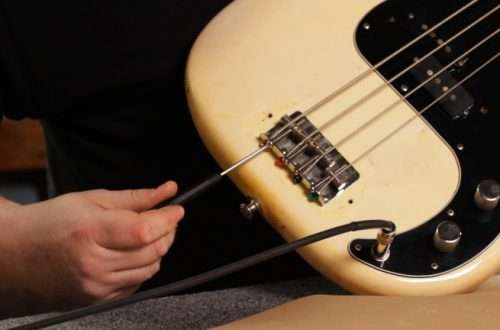
How to tune drums
The ability to tune drums is absolutely necessary if you want to get the best sound from your drum kit. Even if you’re just a beginner drummer, a well-tuned drum kit will help you stand head and shoulders above the rest. This is a snare tuning guide, however, it can be adapted for other types of drums.
Steps
- Disconnect the drum strings with a special lever located on the side.
- Take a drum key (available at any music store) and loosen the bolts that are located on the sides of the drum. Do not completely unscrew each bolt individually. The bolts should be unscrewed gradually each half a turn in a circle. Continue unscrewing the bolts in a circle until you can begin to unscrew them by hand.
- Unscrew the bolts to the end with your fingers.
- Remove the bezel and bolts from the drum.
- Remove the old plastic from the drum.
- Install the new head on top of the drum.
- Install the rim and bolts on the drum.
- Gradually begin to tighten the bolts with your fingers (first without a key). Tighten the bolts with your fingers as far as they will go.
- Check the drum for strength. Apply a few hard blows to the center of the plastic. Don’t worry, you won’t be able to break it. And if you do succeed, take the drum back to the hardware store where you bought it and try a different brand of drum. You must apply enough force to pierce the drum. We do this for the same reasons that guitarists pluck their guitar strings. This is a kind of warm-up of the drum before we start playing it. If this is not done, the drum will be constantly out of tune during the first week. As a result, its new setting will take a lot of time.
- Make sure all bolts are still tight.
- Tighten the bolts with a wrench.Start with the bolt closest to you. Tighten the bolt half a turn with a wrench. Next, do not tighten the bolt closest to it, but go to the bolt that is farthest away from you (the opposite of the one you just tightened) and tighten it with a wrench half a turn. The next bolt to tighten is to the left of the first bolt you started with. Then go to the opposite bolt and continue twisting according to this pattern. Continue twisting until 1) all the bolts are equally tightened 2) you achieve the sound you want. You may need to repeat the twist 4-8 times until you get the sound you want. If the head is new, turn up the volume higher than you want and push the head harder in the center. You will hear the sound become lower. It’s a piece of plastic.
- Walk around the drum and tap the plastic with the drumstick about an inch from each bolt. Listen to the pitch, it should be the same around each bolt. To muffle extraneous sounds or rattles coming from the drum, you can use a gel for silencing such as MoonGel, DrumGum or silencing rings. You should not think that muting will solve the problems of bad drum tuning, but it can improve the sound if it is well tuned.
- Do the same with the bottom (resonant) head.
- Depending on your preference, the pitch of the bottom head should be the same as the pitch of the impact head, or slightly lower or higher.
- However, when tuning the snare, if you want to get a loud, staccato drum sound, pull the top (percussion) head slightly tighter than the bottom head.
- Drum strings are also a very important element. Keep them in perfect condition and try to tension them so that they lie flat against the surface of the drum. If the strings are too tight, they will bend in the middle, and if they are too loose, they will not touch the drum at all. A good rule of thumb for stretching strings is to tighten them exactly until they stop rattling.
Tips
- Unlike many musical instruments, drum tuning is not an exact science. There is no single correct method for tuning a drum kit. It comes with experience. *Try playing with different settings and see what works best for your style of music and the type of drum kit you play.
- Many drummers like to tune their toms in quarter intervals. As in the “Hymn of the newlyweds” (Here comes the bride) – the interval between the first two notes is a quarter.
- Another thing you can do is tune the drum with the bass. Ask someone to help you, it’s very easy. You start tuning on the E string, then the left tom on the A string, the right tom on the D string, and finally the floor tom on the G string, while the snare can be tuned the way you like it to sound. This tuning method depends on the musicality of the ear, as drums are not melodic instruments.
- In this article, we cover only the basic tuning techniques. You should keep in mind that the type of drums, the head of the drums and their size are factors that directly affect the final sound.
- For a quick replacement of plastic, you can buy a drum ratchet wrench that is inserted into a cordless drill. Use a drill with torque setting. It will help you quickly remove the plastic. Then, using the technique described above, try to tune the drum using a torque-set drill. First use the minimum torque, and then try to experiment by increasing the settings. With practice, you’ll learn how to change drum heads in just a few minutes. There are also ratchet wrenches on sale that can be used without a drill. *These wrenches are much safer as they are made specifically for drum tuning – they won’t over tighten the bolts or damage the drum.
- The dedicated DrumDial is also available from many music stores. This device measures the degree of tension of the drum plastic by applying a special sensor to the surface. *Measurement and adjustment can be made until the desired result is achieved. This device will save you time, especially when you need a quick setup before gigs. However, the instrument is not guaranteed to be 100% accurate and the ability to tune by ear can still be very useful.
Warnings
- Do not overtighten your drum, as this can severely damage the drum plastic. If the drum has been overstretched, you will notice it when you remove the head, as there is a dent in the center – this is a sign that the head has been stretched beyond its limit of elasticity.
- Setting the resonant head below the impact head will modulate the sound from top to bottom.
- The previous warnings apply especially to those brave souls who use a cordless drill for tuning.
- Drum sustain may sound good, but it can be a problem for sound engineers who want to record the music from your drum kit and/or amplify the sound through a microphone. *Use muting before amplifying the sound.
How To Tune Your Drums (Jared Falk)





